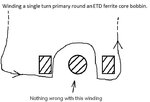T
treez
Guest
Would you agree that it is too risky to get SMPS current sense transformers wound onto ETD type bobbins? After all, if the winders forget to actually cross the primary wire back over itself then the primary may have zero coupling with the secondary, as the attached shows.
As you know, this can't happen with toroid cores since the winding is taken through the centre of the toroid, and therefore, there is always a completed turn of primary coupling up with the secondary.
So do you agree that its best not to wind current sense transformers on ETD type bobbins?
In the attachement, the winder has wound the primary round the bobbin in both cases, but in one picture, it doesn't end up forming a whole turn round the bobbin, which is bad.
As you know, this can't happen with toroid cores since the winding is taken through the centre of the toroid, and therefore, there is always a completed turn of primary coupling up with the secondary.
So do you agree that its best not to wind current sense transformers on ETD type bobbins?
In the attachement, the winder has wound the primary round the bobbin in both cases, but in one picture, it doesn't end up forming a whole turn round the bobbin, which is bad.

